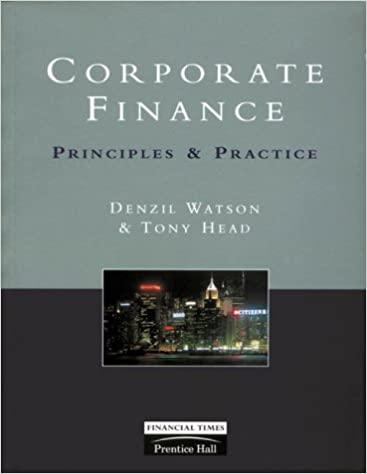Answered step by step
Verified Expert Solution
Question
1 Approved Answer
The following are monthly percentage price changes for four market indexes. Month DIA S&P 500 Nikkei 0.03 1 2 0.02 0.08 -0.01 0.02 0.07 -0.02


The following are monthly percentage price changes for four market indexes. Month DIA S&P 500 Nikkei 0.03 1 2 0.02 0.08 -0.01 0.02 0.07 -0.02 -0.01 3 Russell 2000 0.03 0.10 -0.05 0.04 0.11 -0.10 0.08 0.03 4 0.02 0.05 0.04 0.04 5 0.03 0.06 6 -0.08 -0.03 Compute the following. a. Average monthly rate of return for each index. Round your answers to five decimal places. DIA: S&P 500: Russell 2000: Nikkei: b. Standard deviation for each index. Do not round intermediate calculations. Round your answers to four decimal places. DIA: S&P 500: Russell 2000: Nikkei: c. Covariance between the rates of return for the following indexes. Use a minus sign to enter negative values, if any. Do not round intermediate calculations. Round your answers to six decimal places. Covariance (DJIA, S&P 500): Covariance (S&P 500, Russell 2000): Covariance (S&P 500, Nikkei): Covariance (Russell 2000, Nikkei): d. The correlation coefficients for the same four combinations. Use a minus sign to enter negative values, if any. Do not round intermediate calculations. Round your answers to four decimal places. Correlation (DJIA, S&P 500): Correlation (S&P 500, Russell 2000): Correlation (S&P 500, Nikkei): Correlation (Russell 2000, Nikkei): e. Using the unrounded answers from parts (a), (b), and (d), calculate the expected return and standard deviation of a portfolio consisting of equal parts of (1) the S&P and the Russell 2000 and (2) the S&P and the Nikkei. Do not round intermediate calculations. Round your answers to five decimal places. Expected return (S&P 500 and Russell 2000): Standard deviation (S&P 500 and Russell 2000): Expected return (S&P 500 and Nikkei): Standard deviation (S&P 500 and Nikkei): Since S&P 500 and Russell 2000 have a strong -Select- correlation, meaningful reduction in risk -Select- if they are combined. Since S&P 500 and Nikkei have a strong -Select- correlation, meaningful reduction in risk -Select- if they are combined. The following are monthly percentage price changes for four market indexes. Month DIA S&P 500 Nikkei 0.03 1 2 0.02 0.08 -0.01 0.02 0.07 -0.02 -0.01 3 Russell 2000 0.03 0.10 -0.05 0.04 0.11 -0.10 0.08 0.03 4 0.02 0.05 0.04 0.04 5 0.03 0.06 6 -0.08 -0.03 Compute the following. a. Average monthly rate of return for each index. Round your answers to five decimal places. DIA: S&P 500: Russell 2000: Nikkei: b. Standard deviation for each index. Do not round intermediate calculations. Round your answers to four decimal places. DIA: S&P 500: Russell 2000: Nikkei: c. Covariance between the rates of return for the following indexes. Use a minus sign to enter negative values, if any. Do not round intermediate calculations. Round your answers to six decimal places. Covariance (DJIA, S&P 500): Covariance (S&P 500, Russell 2000): Covariance (S&P 500, Nikkei): Covariance (Russell 2000, Nikkei): d. The correlation coefficients for the same four combinations. Use a minus sign to enter negative values, if any. Do not round intermediate calculations. Round your answers to four decimal places. Correlation (DJIA, S&P 500): Correlation (S&P 500, Russell 2000): Correlation (S&P 500, Nikkei): Correlation (Russell 2000, Nikkei): e. Using the unrounded answers from parts (a), (b), and (d), calculate the expected return and standard deviation of a portfolio consisting of equal parts of (1) the S&P and the Russell 2000 and (2) the S&P and the Nikkei. Do not round intermediate calculations. Round your answers to five decimal places. Expected return (S&P 500 and Russell 2000): Standard deviation (S&P 500 and Russell 2000): Expected return (S&P 500 and Nikkei): Standard deviation (S&P 500 and Nikkei): Since S&P 500 and Russell 2000 have a strong -Select- correlation, meaningful reduction in risk -Select- if they are combined. Since S&P 500 and Nikkei have a strong -Select- correlation, meaningful reduction in risk -Select- if they are combined
Step by Step Solution
There are 3 Steps involved in it
Step: 1

Get Instant Access to Expert-Tailored Solutions
See step-by-step solutions with expert insights and AI powered tools for academic success
Step: 2

Step: 3

Ace Your Homework with AI
Get the answers you need in no time with our AI-driven, step-by-step assistance
Get Started


